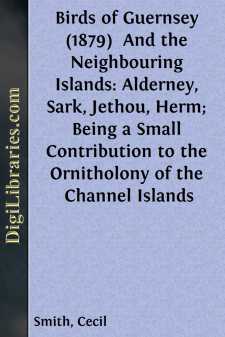Categories
- Antiques & Collectibles 13
- Architecture 36
- Art 48
- Bibles 22
- Biography & Autobiography 813
- Body, Mind & Spirit 141
- Business & Economics 28
- Children's Books 12
- Children's Fiction 9
- Computers 4
- Cooking 94
- Crafts & Hobbies 4
- Drama 346
- Education 46
- Family & Relationships 57
- Fiction 11826
- Games 19
- Gardening 17
- Health & Fitness 34
- History 1377
- House & Home 1
- Humor 147
- Juvenile Fiction 1873
- Juvenile Nonfiction 202
- Language Arts & Disciplines 88
- Law 16
- Literary Collections 686
- Literary Criticism 179
- Mathematics 13
- Medical 41
- Music 40
- Nature 179
- Non-Classifiable 1768
- Performing Arts 7
- Periodicals 1453
- Philosophy 64
- Photography 2
- Poetry 896
- Political Science 203
- Psychology 42
- Reference 154
- Religion 513
- Science 126
- Self-Help 83
- Social Science 81
- Sports & Recreation 34
- Study Aids 3
- Technology & Engineering 59
- Transportation 23
- Travel 463
- True Crime 29
Birds of Guernsey (1879) And the Neighbouring Islands: Alderney, Sark, Jethou, Herm; Being a Small Contribution to the Ornitholony of the Channel Islands
by: Cecil Smith
Categories:
Description:
Excerpt
BIRDS OF GUERNSEY.
1. WHITE-TAILED EAGLE. Haliaeetus albicilla, Linnsaeus. French, "Aigle pygarque," "Pygarque ordinaire."—The White-tailed Eagle is an occasional but by no means uncommon visitant to all the Islands. I have seen specimens from Alderney, Guernsey, and Herm, and have heard of its having been killed in Sark more than once. It usually occurs in the autumn, and, as a rule, has a very short lease of life after its arrival in the Islands, which is not to be wondered at, as it is considered, and no doubt is, mischievous both to sheep and poultry; and in so thickly populated a country, where every one carries a gun, a large bird like the White-tailed Eagle can hardly escape notice and consequent destruction for any length of time. It might, however, if unmolested, occasionally remain throughout the winter, and probably sometimes wanders to the Islands at that time, as Mr. Harvie Brown records ('Zoologist' for 1869, p. 1591) one as having been killed, poisoned by strychnine, in Herm in the month of January. This was, no doubt, a late winter visitant, as it is hardly possible that the bird can have escaped for so long a time, as it would have done had it visited the Islands at its usual time, October or November. All the Channel Island specimens of the White-tailed Eagle which I have seen have been young birds of the first or second year, in the immature plumage in which the bird is known as the Sea Eagle of Bewick, and in which it is occasionally mistaken for the Golden Eagle, which bird has never, I believe, occurred in the Islands. Of course in the adult plumage, when this bird has its white tail and head, no such mistake could occur, but in the immature plumage in which the bird usually makes its appearance such a mistake does occasionally happen, and afterwards it becomes difficult to convince the owner that he has not a Golden Eagle; in fact he usually feels rather insulted when told of his mistake, and ignores all suggestions of anything like an infallible test, so it may be as well to mention that the birds may be distinguished in any state of plumage and at any age by the tarsus, which in the White-tailed Eagle is bare of feathers and in the Golden Eagle is feathered to the junction of the toes. I have one in my possession shot at Bordeaux harbour on the 14th of November, 1871, and I saw one in the flesh at Mr. Couch's, the bird-stuffer, which had been shot at Alderney on the 2nd of November in the same year; and Mr. MacCulloch writes to me that one was wounded and taken alive in the parish of the Forest in Guernsey in 1845. It was said to be one of a pair, and he adds—"I have known several instances of its appearance since both here (Guernsey) and in Herm," but unluckily he gives no dates and could not remember at what time of year any of the occurrences he had noted had taken place. This is to be regretted, as although the bird occurs almost every autumn—indeed, so frequently as to render mention of further instances of its occurrence at that time of year unnecessary—its occurrence in the spring is rare, and some of those noted by Mr....


